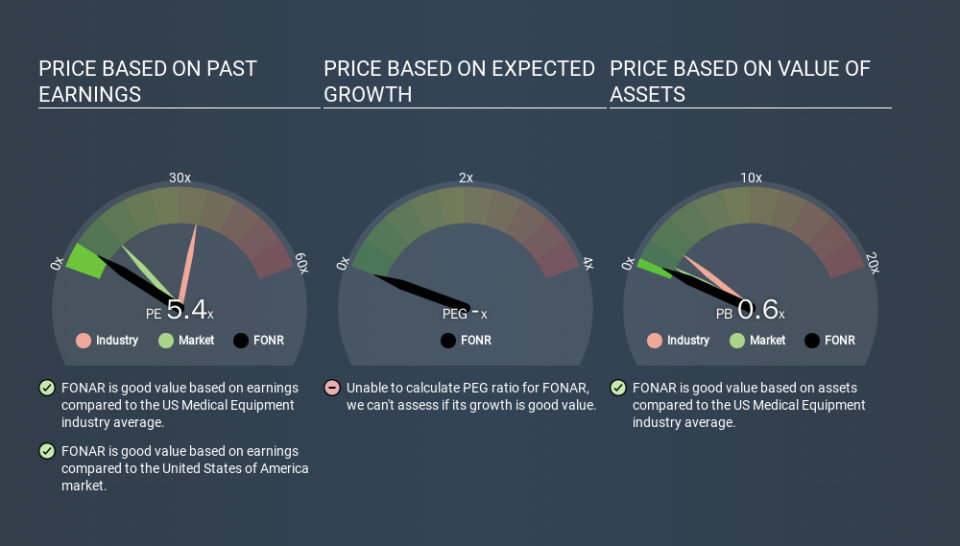How Does FONAR's (NASDAQ:FONR) P/E Compare To Its Industry, After The Share Price Drop?

To the annoyance of some shareholders, FONAR (NASDAQ:FONR) shares are down a considerable 43% in the last month. That drop has capped off a tough year for shareholders, with the share price down 46% in that time.
Assuming nothing else has changed, a lower share price makes a stock more attractive to potential buyers. In the long term, share prices tend to follow earnings per share, but in the short term prices bounce around in response to short term factors (which are not always obvious). The implication here is that long term investors have an opportunity when expectations of a company are too low. Perhaps the simplest way to get a read on investors' expectations of a business is to look at its Price to Earnings Ratio (PE Ratio). Investors have optimistic expectations of companies with higher P/E ratios, compared to companies with lower P/E ratios.
Check out our latest analysis for FONAR
Does FONAR Have A Relatively High Or Low P/E For Its Industry?
FONAR's P/E of 5.41 indicates relatively low sentiment towards the stock. We can see in the image below that the average P/E (35.7) for companies in the medical equipment industry is higher than FONAR's P/E.
This suggests that market participants think FONAR will underperform other companies in its industry. Since the market seems unimpressed with FONAR, it's quite possible it could surprise on the upside. It is arguably worth checking if insiders are buying shares, because that might imply they believe the stock is undervalued.
How Growth Rates Impact P/E Ratios
Companies that shrink earnings per share quickly will rapidly decrease the 'E' in the equation. Therefore, even if you pay a low multiple of earnings now, that multiple will become higher in the future. A higher P/E should indicate the stock is expensive relative to others -- and that may encourage shareholders to sell.
FONAR shrunk earnings per share by 27% over the last year. But over the longer term (5 years) earnings per share have increased by 4.7%. And EPS is down 6.4% a year, over the last 3 years. This could justify a low P/E.
Don't Forget: The P/E Does Not Account For Debt or Bank Deposits
It's important to note that the P/E ratio considers the market capitalization, not the enterprise value. So it won't reflect the advantage of cash, or disadvantage of debt. In theory, a company can lower its future P/E ratio by using cash or debt to invest in growth.
Such spending might be good or bad, overall, but the key point here is that you need to look at debt to understand the P/E ratio in context.
How Does FONAR's Debt Impact Its P/E Ratio?
With net cash of US$30m, FONAR has a very strong balance sheet, which may be important for its business. Having said that, at 40% of its market capitalization the cash hoard would contribute towards a higher P/E ratio.
The Bottom Line On FONAR's P/E Ratio
FONAR trades on a P/E ratio of 5.4, which is below the US market average of 12.2. Falling earnings per share are likely to be keeping potential buyers away, the relatively strong balance sheet will allow the company time to invest in growth. If it achieves that, then there's real potential that the low P/E could eventually indicate undervaluation. Given FONAR's P/E ratio has declined from 9.5 to 5.4 in the last month, we know for sure that the market is more worried about the business today, than it was back then. For those who prefer invest in growth, this stock apparently offers limited promise, but the deep value investors may find the pessimism around this stock enticing.
Investors should be looking to buy stocks that the market is wrong about. If it is underestimating a company, investors can make money by buying and holding the shares until the market corrects itself. We don't have analyst forecasts, but you might want to assess this data-rich visualization of earnings, revenue and cash flow.
Of course you might be able to find a better stock than FONAR. So you may wish to see this free collection of other companies that have grown earnings strongly.
If you spot an error that warrants correction, please contact the editor at editorial-team@simplywallst.com. This article by Simply Wall St is general in nature. It does not constitute a recommendation to buy or sell any stock, and does not take account of your objectives, or your financial situation. Simply Wall St has no position in the stocks mentioned.
We aim to bring you long-term focused research analysis driven by fundamental data. Note that our analysis may not factor in the latest price-sensitive company announcements or qualitative material. Thank you for reading.

